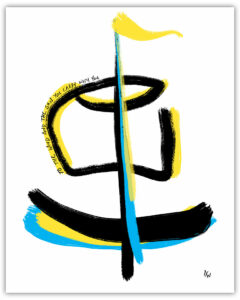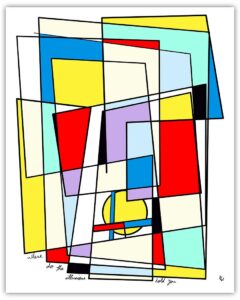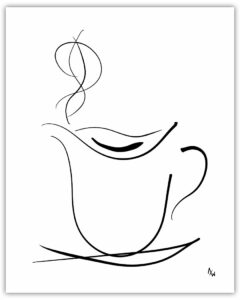EXPLORING CREATIVITY & CREATIVE PRACTICE
I’ve worked in creative fields for many years as a writer and photographer. I’ve worked in those ways a lot of creative people make their livings: by getting a tangentially creative job that provides consistency and relative security of salary and benefits — and a somewhat narrow lane within which to “create.”
I put quote marks on that “create,” because somewhere in me there is a vague line of thinking between what it means to create “for real” (my own free, intuitive, divinely creative ideas) and what it means to be creative within a defined role, a role defined by others, by employers or clients with certain expectations.
How much room is there in that job for me versus my being a cog in the machine, viewed as an interchangeable body in a position charged with executing on X, Y and Z largely in the way it’s expected or even dictated?
The ideal, I imagine, is to be able to blend the autonomy of one’s self as an artist and as a commercially desirable creator. In fact, I often think, “I want people to pay me to be me.” Meaning, I want to create something that is of value to me and to clients, that we discover an authentic overlap of our interests and values, of ways of communicating in the world, that I don’t need to shape-shift who I am to meet generic ideas of who they want me to be.
For too long I believed that wasn’t possible, that it wasn’t even worth the effort to see if it is possible. I believed the naysayers, the doubters who are uncomfortable with finding out or with believing. I trusted their doubts and took them on for myself.
 I didn’t study art in school at any point, despite a deep-seated curiosity and interest in doing so. I believed and feared the myth of there being no practical path for a life in that lane.
I didn’t study art in school at any point, despite a deep-seated curiosity and interest in doing so. I believed and feared the myth of there being no practical path for a life in that lane.
The first money I made as a writer and photographer was in journalism. Then it was in corporate communications and corporate journalism (branded magazines) for a global company.
Later, it was in content marketing roles that allowed me to expand my creative skills to ad concepts, design and video, too. Nonetheless, I still was creating for the purpose of someone and something else.
All were worthy jobs that I enjoyed — for what they were. I learned things. I developed skills. And I continued to want something more. That voice in me might have gone to sleep from time to time, but it never left me.
So naturally, when it came to my off-hours personal creating, when I was in one of those occasional periods over the years, my impulses largely leaned on my existing skills. I have written poetry and made photographs for years. I dabbled here and there with painting; small steps into the unknown, but always kept private.
In the past few years, I have been exploring more. I have dipped into making simple line drawings and abstracts, using stark black-on-white and vivid colors. Still, I might only do it for a number of days or weeks, then let it fall to the side again as the seemingly more pressing matters of daily life intervened. I didn’t make time for the practice. I didn’t truly, then, even make it a practice.
Then, this fall, I committed to finally exploring more deeply and lastingly my creative interests in drawing, illustration and design. And I’ve found that I’m unintentionally back in the waters where I’ve played on and off for years: simple lines and abstracts.
So much of what I do, think and read about, and create focuses on simplicity. In art and in life. It feels like a constant challenge, a constant aspiration or ideal that I struggle to bring in line: a simple way of living and of making sense of things.
I have a spiritual practice — yoga, meditation — in which I strip away the excesses and focus within. It’s a perpetual challenge. The mind (ego) is forever trying to pull me out of my heart, out of my inherently creative space. (You have that space — and challenge? — too; I’m sure of it.)
This fire one walks through in a daily creative practice, just as in a spiritual one, is deeply rooted in a process of unbecoming. It leads to revelation of who we really are.
Now, in my recently renewed creative practice, I’m working digitally. My wife, Becca, turned me onto the Procreate app on her iPad. I invested in my own iPad. I launched my online shop to give me a place and purpose to make my work available to the public (again, at my wife’s urging).
I’m consciously drawing and creating work daily that takes me beyond the tried and true of my past creative outlets: writing and photography. And I’m sharing it publicly on Instagram, Pinterest and on this blog. And in my online shop.
Sharing it publicly feels like an important part of the process. It forces me to confront my vulnerability and fears daily. It gives me the opportunity to receive feedback. And it recognizes that there is no arrival point beyond right now.
I can’t point to the “right” or “best” time to say, “I’m ready. Now I know my art is what it should be. Today is the day to open an online shop and to show in galleries.”
The whole thing is a process without destination beyond the moment of now, the work of now. It’s this now that leads to the next and the next. There is no tomorrow without today. There is no “Z” piece of artwork without having learned and been influenced by my work on pieces “X” and “Y.”
This daily practice of creating and sharing publicly forces me to grow. It expands my comfort zone. It calls on me to create create create and demands that I face the Resistance. It calls on me to trust my heart, rather than listen to my intrusive mind.
 It means working through the fear of whether my forms of simplicity are inferior to someone else’s overt complexity. Of working through the fears of selling and not selling. Of facing the fear of what “they” will say.
It means working through the fear of whether my forms of simplicity are inferior to someone else’s overt complexity. Of working through the fears of selling and not selling. Of facing the fear of what “they” will say.
This fire one walks through in a daily creative practice, just as in a spiritual one, is deeply rooted in a process of unbecoming. It leads to revelation of who we really are.
To unbecome my perceptions of what it means to be an artist. To unbecome those societal boxes of “shoulds” (I should be, say, make or do “X”). To unbecome the myths that surround being an artist (starving, flighty, mercurial). To unbecome whatever “they” think I am, and what I have bought into thinking that I am.
It means being patient with myself as I explore beyond my previously known understanding of the world, and as I don’t feel like I know much of what I’m doing, if it’s “right” or not, if it has a place and worth.
Just as I did when I started showing and selling my art photography in galleries these past couple of years. Just as I did when I created the Humanitou website and started having and publishing my conversations with artists more than three years ago, and then when I transitioned that into the Humanitou Podcast early this year.
It means being patient as I bring many years’ worth of creative experience — of learning all the ways and things I’ve learned about communicating visually and in text, and how to marry the two, and in distilling the complex into the simple (e.g. poetry, ad copy) — into this new territory for me. And in knowing I’m not a novice, though I’m exploring more fully these visual ways of expressing myself.
To unbecome means putting in the consistent, joyful work that is leading me somewhere, even though the work I’m creating is across a range of differing styles and approaches, and I don’t know where I’m heading with it.
Right now, I create abstract digital paintings and, from my background with words, incorporate thoughtful phrases within them. I also make simple line drawings, some showing recognizable objects of interest to me and some abstract. I see eyes (vision) coming through in my exploration in the varied visuals. There’s black-and-white, and there’s color.
 From a commercial standpoint, it looks to me like artists often refine their focus to one style and/or subject matter. They produce work that becomes recognizable without seeing the name signed on it or promoted with it. You see it, and you know whose it is.
From a commercial standpoint, it looks to me like artists often refine their focus to one style and/or subject matter. They produce work that becomes recognizable without seeing the name signed on it or promoted with it. You see it, and you know whose it is.
Gallerists often want to represent artists who produce lines of work that meet this recognizability criterion. To have a multitalented, multipotentialite artist working in varied media doesn’t present as streamlined and easy and digestible a look on Instagram or on a gallery’s walls, it seems.
So where does my array of recent work fit into my future? I don’t know. I think it’s difficult to choose one way to go. Yet I recognize that possibly I’m working my way to something more readily definable as a style and a voice, as I create more, refine skills and ideas.
Maybe it’s true that this one distinctive style in my work — or lack of one — will make the difference in the financial flow of my own online shop, and in other opportunities that come — or not. And maybe I’m just another creative person who has a lot of interests, and they all get to have a place at the table. And that different people with different views will buy different pieces of my work.
Time and the work — the steady, joyful connection with whatever is in me that wants to be out of me — will tell.
In the meantime, there’s a good chance that prints of something you like in one style or another are in the shop, or on its way there. See more on my Instagram and Pinterest pages. If you see something on those pages that aren’t currently showing in my shop, reach out and I can make it available.


